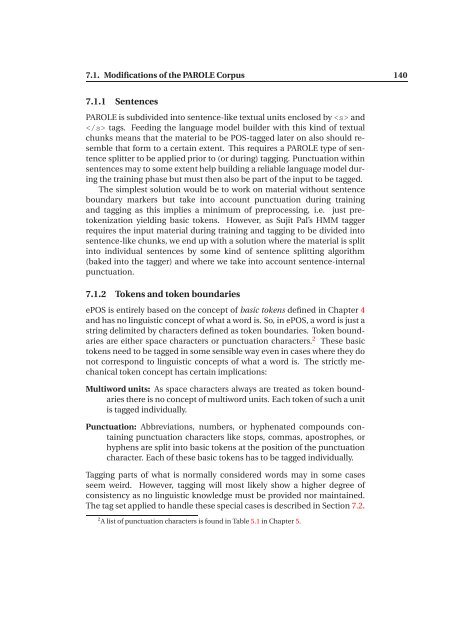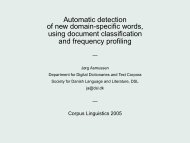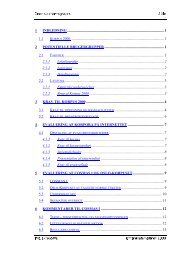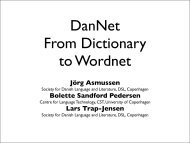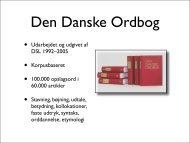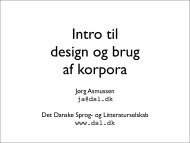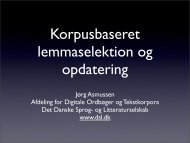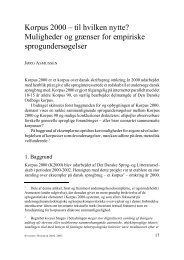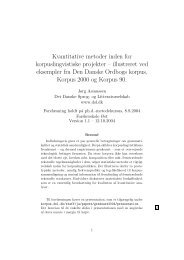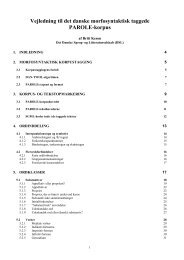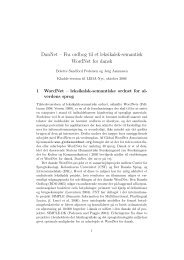The Corpus Thread - Det Danske Sprog- og Litteraturselskab
The Corpus Thread - Det Danske Sprog- og Litteraturselskab
The Corpus Thread - Det Danske Sprog- og Litteraturselskab
You also want an ePaper? Increase the reach of your titles
YUMPU automatically turns print PDFs into web optimized ePapers that Google loves.
7.1. Modifications of the PAROLE <strong>Corpus</strong> 140<br />
7.1.1 Sentences<br />
PAROLE is subdivided into sentence-like textual units enclosed by and<br />
tags. Feeding the language model builder with this kind of textual<br />
chunks means that the material to be POS-tagged later on also should resemble<br />
that form to a certain extent. This requires a PAROLE type of sentence<br />
splitter to be applied prior to (or during) tagging. Punctuation within<br />
sentences may to some extent help building a reliable language model during<br />
the training phase but must then also be part of the input to be tagged.<br />
<strong>The</strong> simplest solution would be to work on material without sentence<br />
boundary markers but take into account punctuation during training<br />
and tagging as this implies a minimum of preprocessing, i.e. just pretokenization<br />
yielding basic tokens. However, as Sujit Pal’s HMM tagger<br />
requires the input material during training and tagging to be divided into<br />
sentence-like chunks, we end up with a solution where the material is split<br />
into individual sentences by some kind of sentence splitting algorithm<br />
(baked into the tagger) and where we take into account sentence-internal<br />
punctuation.<br />
7.1.2 Tokens and token boundaries<br />
ePOS is entirely based on the concept of basic tokens defined in Chapter 4<br />
and has no linguistic concept of what a word is. So, in ePOS, a word is just a<br />
string delimited by characters defined as token boundaries. Token boundaries<br />
are either space characters or punctuation characters. 2 <strong>The</strong>se basic<br />
tokens need to be tagged in some sensible way even in cases where they do<br />
not correspond to linguistic concepts of what a word is. <strong>The</strong> strictly mechanical<br />
token concept has certain implications:<br />
Multiword units: As space characters always are treated as token boundaries<br />
there is no concept of multiword units. Each token of such a unit<br />
is tagged individually.<br />
Punctuation: Abbreviations, numbers, or hyphenated compounds containing<br />
punctuation characters like stops, commas, apostrophes, or<br />
hyphens are split into basic tokens at the position of the punctuation<br />
character. Each of these basic tokens has to be tagged individually.<br />
Tagging parts of what is normally considered words may in some cases<br />
seem weird. However, tagging will most likely show a higher degree of<br />
consistency as no linguistic knowledge must be provided nor maintained.<br />
<strong>The</strong> tag set applied to handle these special cases is described in Section 7.2.<br />
2 A list of punctuation characters is found in Table 5.1 in Chapter 5.


